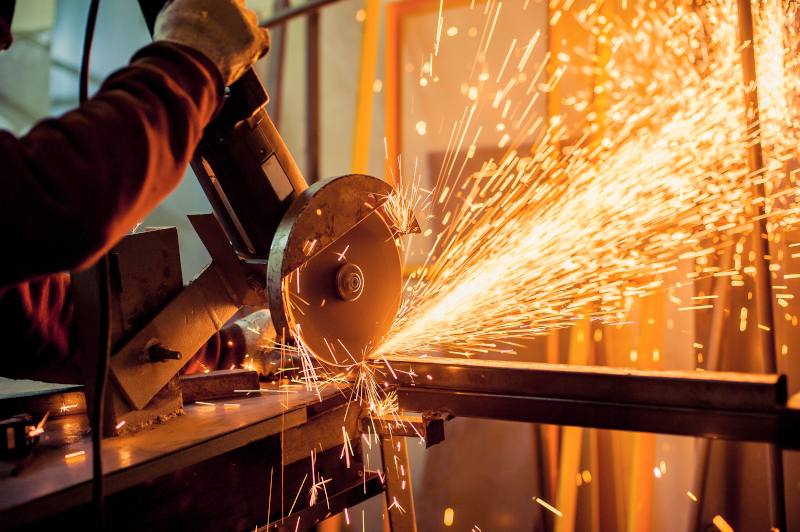
The deindustrialisation that the UK has experienced over the last 40 years has been a disaster. We will never get our economy rebalanced and growing fast enough to raise average living standards unless we have a manufacturing revival.
During the decade running up to 2019, the UK economy grew cumulatively at an average rate of about 1.4% per annum. As our population rose over this period by nearly 0.8% a year on average, GDP per head increased by only about 0.6%, which is not sufficient to raise mean disposable incomes. There is thus a real danger, after the Covid-19 setback at the beginning of this decade, that average UK living standards are going to be no higher in the UK in 2030 than they were in 2019 or even 2007, before the 2008 financial crash. Therefore, we may be in for a whole generation of stagnant disposable incomes.
Why is the UK growth rate so low?
Economic growth clearly depends very largely on investment and the proportion of our GDP which the UK invests – at about 17% – is far below the world average of 25% and still further below the 30% plus which it is in many countries located along the Pacific Rim.
And why is it so low in the UK? It is because investment projects which are profitable in many parts of the world are unprofitable in the UK because – taking into account the actual levels of productivity which we manage to achieve – the cost of producing most goods and services in the UK is much higher than it is elsewhere.
This is important across all production but not so significant for services which are both less price-sensitive than manufactures and where we have a number of key natural advantages in our language, geography, universities, legal system and the skill of our labour force, particularly in financial services. In manufacturing, we have none of these advantages while price competitiveness is much easier to determine than it is in most services and is therefore even more crucial.
Overwhelming evidence that this is the case comes from two sources. One is our share of world trade, which has gone down and down. In 1950 it was 11.1%. By 1985 it had fallen to 5.5% and it is now 2.5%. The other is the proportion of our national income which comes from manufacturing, the sector in which competition in international trade is most keenly felt. Even as late as 1970 just under a third of our GDP came from manufacturing. Now it is less than 10% and still drifting down.
Why is it so much more experience to produce good in the UK than it is elsewhere?
It is because we charge out all the sterling costs incurred in manufacturing at too high a rate. ONS figures show that, on average, the cost of raw materials, machinery and components makes up about 30% of total manufacturing costs. For these inputs, there are world prices that stay the same in world currency terms whatever happens to the exchange rate. All the other 70% of total charges – for wages, salaries, overhead costs, interest, and taxation – are incurred in the domestic currency, sterling of course in our case. All these costs then have to be recovered in export prices and the higher the exchange rate, the higher our export prices have to be.
And why is our exchange rate so high?
It is partly that a strong pound is liked and supported by people who want cheap holidays abroad and low prices for imported goods in our stores, so it is politically popular. It is partly because of inertia; it is what we are used to. The fundamental reason, however, is that for the last forty years, since the arrival of monetarism and neoliberalism, the main economic policy target which we – and most of the West – have pursued is keeping inflation down rather than getting the growth rate up.
For a long time, this meant high interest rates and tight money, all of which drove up the exchange rate. It is no coincidence that we started deindustrialising in the 1980s when the western world was engulfed in inflation and hard money policies replaced the previous more accommodating Keynesian regime, which had led to much higher growth rates in the USA, Europe and Japan than we see now.
And what happened as a result of our export prices for manufacturers being too high was that investment in our export industries slumped down. This was important for our overall economic performance but amplified because of the shift in the categories of investment which then took place. This is because the overall – or social – rate of return on different categories of investment varies so widely.
The social rate of return includes not only a reward for whoever puts up the money to pay for the investment concerned in the first place but also the benefit to GDP from better and often cheaper products, combined with higher wages, greater profitability and a stronger tax base from increased output per hour.
Most types of investment – in schools, hospitals, road, rail, public buildings and housing in the public sector, and new office blocks, shopping malls, IT installations, projects such as new restaurants and again housing in the private sector – don’t contribute in this way to any great extent. Those that do are in quite a narrow range of categories clustering round mechanisation, the application of technology and the use of power.
Instead of producing a social rate of return of around 5%, like other types of investment, careful analysis shows that they can achieve overall returns of 50% per annum or more. And these types of investment typically find their home in the light internationally traded and highly competitive light industrial sector. If prices are too high, alternative location for investment – in China, Germany, or Holland – will be chosen. This is our problem.
How can we overcome it?
The only way to do so is by running our economy – and particularly our macroeconomic and exchange rate policies – in the interest of manufacturing rather than services, and we need to do this for four main reasons, all of which highlight how important manufacturing is to our economy.
The objective has to be to rebalance our economy by lifting the proportion of UK GDP coming from manufacturing from 10% to at least 15%. As part of this process, we will need to shift about 8% of our GDP out of consumption and into investment, with around half – 4% – going into mechanisation, technology and power, with a 50% annual rate of return.
A 4% increase in investment of this high-powered type, achieving a 50% annual return, would give us the 2% per annum increase in GDP we need every year both to keep up with the rest of the world, to enable us to reduce the government debt burden, and to raise living standards. We could then get the economy to be 30% bigger by 2030 than it otherwise would be. But this will never happen unless we make it profitable to invest in manufacturing-based export led growth.
